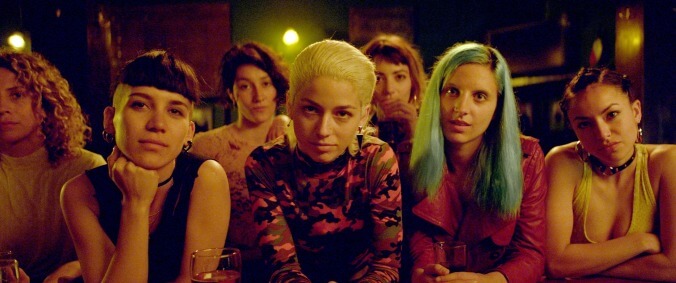The threat of being labeled a “bad mother” remains an effective way of keeping women in line. That’s not to say, of course, that there’s no such thing as inappropriate parenting. The tension between these realities runs through the latest film from Jackie director Pablo Larraín. Ema (Mariana Di Girólamo) is a free spirit, a bisexual professional dancer whose interests include personal expression through movement and playing with her flamethrower. Following an enigmatic opening that sees her gleefully lighting up a power transformer like an arthouse Harley Quinn, she’s continually subject to judgmental looks and lectures—mostly from other women, but also from her husband, Gastón (Gael García Bernal), a choreographer 12 years her senior. At first, one might assume that these people are simply threatened by Ema’s unconventional ideas and lifestyle. But it turns to be more complicated than that.
This is an onion with a lot of layers. Without peeling all of them back, it can be revealed that Ema and Gastón adopted a little boy, Polo, about a year earlier. But he’s not living with them anymore. Returning a pet to the shelter carries enough stigma, but a child? As Ema puts it, “People look at us in public like we suffocated a dog with a plastic bag.” Predictably, Ema bears a disproportionate share of this shame, which Gastón wields as abusively as some spouses do their fists. So Ema breaks away, siphoning members of Gastón’s company to form a polyamorous girl gang of artistic terrorists who spend their time dancing to reggaeton music—a genre that Gastón always considered beneath them. They also, to put it bluntly, fuck everything that moves. But is this explosion of orgiastic excess a defiant act of personal liberation, or is it a coping mechanism born of grief and despair? Maybe both, maybe neither.
Regardless of the impetus—this movie practically dares you to judge Ema, who stares defiantly at the camera as if to say, “what of it?”—the crew’s exploits seem like a lot of fun. They certainly look good, as Larrain’s camera swoops and pivots around bodies in ecstatic motion in the dance sequences that are woven into the film. The director does draw a distinction between the bourgeois confines of Gastón’s theater and the freer, more sexually charged expression taking place on the streets of Valparaiso, the Chilean port city where our story takes place. But both seem designed to draw viewers into the groove of the movie, to get us to loosen up our shoulders and live a little. The exquisitely pitched gummy-bears-and-beachside-neon color palette is similarly vibrant and intoxicating. So, too, is the edgy fashion sense of Ema and her crew. (There are a lot of angular haircuts in this movie.)
Larraín saves the alienating stuff for the content of Ema, which is as hyper-stylized and disorienting as viewers have come to expect from the Chilean writer-director. There’s the dialogue, for example, which loops accusations and confessions into dizzying knots as characters reveal nothing and everything at the same time. There’s the jarring tonal shifts between domestic melodrama and impressionistic hedonism—a bit like if Climax and Marriage Story were cut together on the same reel—and the unstructured, fragmented ways that the details of Ema’s story are dished out. Most of all, there’s the fact that this ostensible character study tells us very little about its title character, conveying more of how other people see her, and how she manipulates that to her advantage, than how she sees herself. Under the weight of Larraín’s visual style, the emptiness at the center of Ema’s character nearly collapses the film, before a gobsmacking ending reveals her true motivations.
As a filmmaker, Larraín is concerned with image, and with the faces we show to the world versus the ones we keep to ourselves. In Ema, that dichotomy explodes from the pressures put on his eponymous heroine. Ema has neither the time nor the inclination to be the person that society (or her husband) wants her to be. Asked by a potential employer what she would like to teach to the children at an elementary school in need of a dance instructor, she replies simply, “Freedom.” She does things her way, all the time, acting on instinct without compromise or concern. Does that make her a bad mother? Larraín leaves that for the audience to decide.


 Keep scrolling for more great stories from A.V. Club.
Keep scrolling for more great stories from A.V. Club.